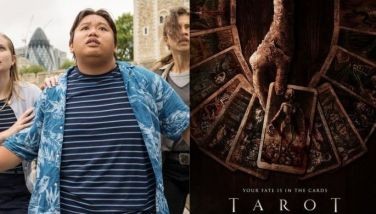Shakespeare in black & white
Theater Review: Haring Lear
MANILA, Philippines - Local audiences have been getting a dose of the Bard Titus Andronicus at UP and William at PETA Theater Center last year, among other shows, and even from Hollywood, such as the recent Coriolanus directed by and starring Ralph Fiennes, an adaptation of another tragedy with a relatively brief but magnificent performance by the great Vanessa Redgrave.
With the local theater scene in full throttle, the Philippine Educational Theater Association (PETA) offers Filipinos yet another Shakespearean drama at PETA in Quezon City with support from the British Council and the National Commission for Culture and the Arts. It is a monumental, masterful stage production of one of William Shakespeare’s greatest tragedies (alongside the more often staged and filmed Hamlet, Othello and Macbeth), King Lear. Adapted by National Artist Bienvenido Lumbera and directed by Nonon Padilla, it now carries the title Haring Lear.
Padilla a.k.a. Felix Guerrero Padilla Jr., a stalwart of Philippine theater for several decades now, and a daring, brave and imaginative artist, tackles a difficult Shakespeare opus, an ambitious effort for any stage director, and comes up with an astonishing theatrical work. Padilla quotes Lumbera as saying that this version of King Lear is a “textual adaptation rather than a straightforward translation.” Lumbera says this allows the actors to deliver the Tagalog/Filipino lines with ease and the Filipino audience to understand them better, even if the adaptation may unavoidably depart from so-called “faithful translation.”
With help from Gino Gonzales (production design) and Jonjon Villareal (lighting and technical direction), Padilla creates a look that suggests drama and timelessness. Padilla says that Gonzales is a faithful disciple of the recently-departed National Artist for Theater Design Salvador Bernal. The student should do the memory of his mentor proud.
The sets are awesome sheer giant nets that keep the characters and sets in a haze at the beginning, a tapestry of cobweb-like fabrics and metal, and two descending “chandeliers.” The costumes are an integral part of Padilla’s recreation of the play.
Like the sets, they are in black and white, even as the characters run the gamut of emotional colors from black to white, green to blazing red. The ensemble is garbed in black save for the outfits worn by a character named Cordelia, the youngest of three daughters of the title character, and the only sympathetic one, the only character to wear a gown, and white too, which while stating the obvious the woman’s purity makes a dramatic visual impact.
The “Matrix” generation will surely find these black costumes cool. The actors sport skinheads, save for the principal character. Their uniform look may make it more difficult for the audience to identify the characters or identify with them as well as their roles and genders but it certainly demands more in the sense that viewers are made to participate in knowing the characters and empathizing with them.
The all-male casting revives the old (taken-for-dead) theatrical tradition of assigning men to female roles, such as the stage plays at the then exclusively male Ateneo enclave from the ’60s and earlier. Yes, the guys did it in drag and all for the love of theater and the arts. Moviegoers may remember that a key element in Shakespeare in Love was that women were barred from performing during the Renaissance, the movie’s time setting.
 Myke Salomon as Edgardo
Myke Salomon as Edgardo For its current production, PETA has assembled actors from various fields the pop music scene, indie films, commercials, television, and theater including Shakespeare plays. One rarity here: All of them understand their Shakespearean roles from the dramatic highs and lows, right down to the tone and nuances of dialogue. No actor may be heard making a mechanical recitation of lines.
Haring Lear is an ensemble as well as individual achievement. It’s a strong cast with the participation of Nor Domingo as Goneril, Gary Lim as Regan, and Abner Delina Jr. as Cordelia and the disguised Lakayo, Lear’s three daughters, not to overlook Myke Salomon (a.k.a. DJ Myke and Sabado Boy) as Edgardo and Jay Gonzaga as Edmundo. Others in the cast are Renante Bustamante, Ernie Cloma, George de Jesus III, Fredyl Hernandez, Jeff Hernandez, Angelo Moratilla, Josel Reyes and Jack Yabut.
Teroy Guzman as Lear projects the commanding presence of the doomed King, and negotiates the long and complicated roads of his pitfalls and downfall. A curious feat: Guzman has a long, punishing aria as he curses the heavens while acting in the rain. We are sure that for both the actor and his character, it isn’t a glorious feeling, his shouting at clouds so dark up above while cool waters pour on his body unceasingly. (This is done with two shower caps attached to water hoses which follow his movements.)
Co-actor Salomon is similarly soaked albeit more tentatively in the protracted scene. The rain-drenched Guzman goes about this business for something like less than half an hour and yet with no worries about his health and ability to perform the next day. The local press likes to refer to this type of performer as a trouper.
Worth noting is Dodgie Gonzales’ inconspicuous but no less effective music design a strain from Beethoven here, a vintage cabaret ballad there. The bits of music and the visuals complement Padilla-Lumbera’s concept of the show.
The play runs for nearly four hours with only 10 minutes of intermission, but one could almost feel the rapt silence of the audience as they follow the saga of a powerful man and his three daughters, his fall, the parallel rise and fall of another man and his two sons, some hand combat, violence, blood, deaths, and the eternal sorry state of the human condition. Sensational. Shakespeare is never kid stuff.
Padilla uses the meager resources of theater brilliantly. In one moment, he condenses a battle scene with a thin white curtain through which may be seen two cardboard horses, one with the British flag and the other the French, charging at each other.
The story is pure soap opera. It is never superfluous to mention that Shakespeare wrote and staged his plays during the Elizabethan era not for intellectuals but for the masses who wanted popular entertainment. Lumbera makes it a point that through the trials and tribulations of the king, his loved ones, and all the others around him, the audience listens to and follows the actors iterate their lines. Not a mouse stirred.
- Latest
- Trending

























 Exclusive
Exclusive


